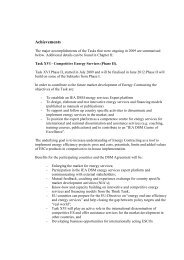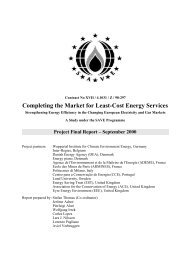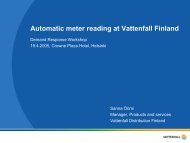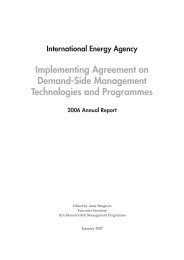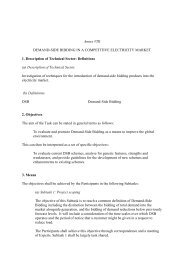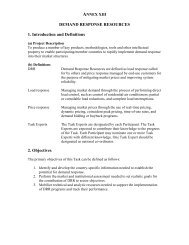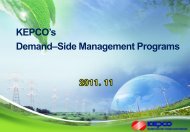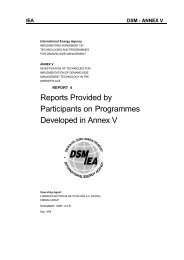Summary and conclusions - IEA Demand Side Management ...
Summary and conclusions - IEA Demand Side Management ...
Summary and conclusions - IEA Demand Side Management ...
Create successful ePaper yourself
Turn your PDF publications into a flip-book with our unique Google optimized e-Paper software.
6 Subtask 7: Stakeholders involved in the penetration <strong>and</strong>effects on the stakeholders6.1 <strong>Summary</strong> of the stakeholders’ involvementIn the Subtask 7 the following report has been produced: Stakeholders involved in the deployment of microgeneration <strong>and</strong> new end-use technologies.Subtask 7 Report [8]The report discusses different stakeholders involved in the penetration of microgeneration <strong>and</strong> newend-use technologies, as well as effects on the stakeholders. Microgeneration includes e.g. solarpower (photovoltaics <strong>and</strong> concentrated solar power), small wind turbines <strong>and</strong> micro-CHP; new endusetechnologies include heat pumps <strong>and</strong> electric vehicles with smart charging. The characteristicfor these technologies is that they are installed at the consumer’s premises <strong>and</strong> generate powermainly for the consumer himself. We also considered the rough power limit for microgeneration tobe 50 kW e .We identify a number of stakeholders to whom microgeneration <strong>and</strong> new end-use technologies canpresent significant effects. Most importantly, the consumer himself, network companies <strong>and</strong>electricity supplier (retailer) are involved. Network companies may either benefit or suffer from theintroduction of microgeneration, heat pumps <strong>and</strong> EV, depending on the specific technology <strong>and</strong>how it is used. The consumer can contract an aggregator to sell the microgeneration or reprofiledconsumption to competitive energy market participants or network companies. Manufacturers striveto develop more affordable <strong>and</strong> more efficient generating units, normally with the help of subsidiesprovided by governments.The scope of this report is indeed wide. The report reviews the various questions the stakeholdershave to consider related to the introduction of the new generation <strong>and</strong> end-use technologies.Examples include operation of the microgenerators <strong>and</strong> EV charging systems, communication,effects on power quality, network stability <strong>and</strong> network capacity, emissions, energy efficiency, etc.In some cases, the questions can turn out to be serious barriers.It is difficult to draw general <strong>conclusions</strong> about the costs <strong>and</strong> benefits to each stakeholder. In eachcase they depend on the details of technologies <strong>and</strong> their methods of control, as well as on thestakeholders themselves <strong>and</strong> the details of contracts between them.The appendices provide some examples of stakeholder involvement from four different countries:6.2 Spanish business cases for EV <strong>and</strong> smart metersIn the case of EV, an aggregator of electric vehicles is the commercial middleman between acollection of PEVs <strong>and</strong> electric system agents (TSO, DSO, retailers). From the TSO perspective, theaggregator is seen as a large source of generation or load, which can provide ancillary services <strong>and</strong>can also participate in the electricity market with supply <strong>and</strong> dem<strong>and</strong> energy bids, as indicates in thefollowing market model.18



